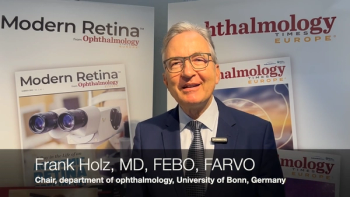
SAKURA program reinforces efficacy, safety of intravitreal sirolimus
Results from the Study Assessing double-masKed Uveitis tREAtrement (SAKURA) program support the efficacy and safety of intravitreal sirolimus 440 mcg (Opsiria, Santen) for treating noninfectious uveitis of the posterior segment, said Pauline T. Merrill, MD.
Editor's note: A previously published version of this article incorrectly stated there were two serious adverse events associated with the SAKURA program. There was only one case of confirmed culture-positive endophthalmitis observed with the 880 mcg dose group.
Results from the Study Assessing double-masKed Uveitis tREAtrement (SAKURA) program support the efficacy and safety of intravitreal sirolimus 440 mcg (Opsiria, Santen) for treating noninfectious uveitis of the posterior segment, said Pauline T. Merrill, MD.
“The SAKURA program is the largest study of non-infectious uveitis of the posterior segment to date, with almost 600 subjects enrolled in the two sequentially performed phase III randomized, double-masked, multinational studies,” said Dr. Merrill, assistant professor of ophthalmology and section director, uveitis and ocular inflammation, Rush University Medical Center, Chicago.
“The SAKURA data show that sirolimus 440 mcg has a favorable benefit:risk profile, and it was particularly effective in the population of patients with multiple measures of inflammation,” Dr. Merrill said. “Ocular serious adverse events were not unexpected, and there was a very low incidence of ocular adverse events that are common with intraocular corticosteroids.”
SAKURA 1 randomized 347 patients to treatment every 2 months with sirolimus 440 mcg, 880 mcg, or 44 mcg as an active control. Inclusion and exclusion criteria were designed to ensure the enrolled subjects had active non-infectious uveitis of the posterior segment.
Eligible patients had to have a vitreous haze score (modified Standardization of Uveitis Nomenclature scale) ≥ 1.5, best corrected visual acuity (BCVA) ≥ 19 ETDRS letters ( ≥ 20/400) in the study eye and ≥ 20/200 in the fellow eye, and no evidence of active ocular infection.
The protocol required topical corticosteroids and nonsteroidal immunosuppressive agents to be discontinued prior to enrollment and a compulsory rapid taper of any systemic corticosteroids upon entry.
Topical corticosteroids were to be tapered to discontinuation by study day 1 and immunomodulators discontinued 30 days prior to day 1. Systemic corticosteroids were allowed only for subjects already receiving them at baseline and had to be rapidly tapered post-baseline.
The primary efficacy outcome was the proportion of patients with a vitreous haze score of 0 at month 5, and analyses of the data in SAKURA 1 showed superiority of the sirolimus 440 mcg compared with both the 44-mcg active control and 880-mcg dose groups (22.8% versus 10.3% and 16.4%, respectively). The difference between the 440 mcg and 44 mcg doses was statistically significant (p = 0.01).
Protocol amended
“Based on the results in SAKURA Study 1, the protocol for SAKURA 2 was amended to eliminate further evaluation of the 880 mcg dose. Otherwise, the protocol of SAKURA 2 remained identical to SAKURA 1,” said Dr. Merrill.
In SAKURA 2, the second phase III study which included 245 patients randomized to treatment, sirolimus 440 mcg did not show statistical significance, though clinical findings provide supportive evidence of efficacy. The percentage of patients achieving a visual haze score of 0 at month 5 in the 440 mcg and 44 mcg groups was 19.1% and 17.6%, respectively (p = 0.783).
In an integrated analysis of data from SAKURA 1 and 2, which included patients in both the 440 mcg (n = 08) and 44 mcg (n = 208) groups, the percentage of patients achieving a vitreous haze score of 0 was significantly greater in the sirolimus 440 mcg group compared with the control population, 21.2% versus 13.5%, respectively (p = 0.038).
The efficacy of sirolimus 440 mcg for resolving vitreous haze in the population of patients with multiple measures of inflammation was evaluated in a post hoc analysis that included study subjects who had a vitreous haze score ≥ 1.5 and at least one of the following characteristics: BCVA ≤ 75 ETDRS letters, requirement for systemic corticosteroids (prednisone-equivalent dose ≥ 7.5 mg/day), or presence of macular edema (central retinal thickness ≥ 300 µm on optical coherence tomography). About 80% of patients in both the sirolimus 44 and 440 mcg groups met these criteria.
Whether considering patients in the individual SAKURA studies or the integrated population, there was a statistically significant difference favoring sirolimus 440 mcg versus 44 mcg in the analysis of the percentage of patients achieving a vitreous haze score of 0 at the primary endpoint. In the integrated analysis, 21.1% of patients receiving sirolimus 440 mcg and 8.0% of the control group achieved the primary endpoint (p < 0.001).
“When we see uveitis patients, we are looking at numerous signs of inflammation in addition to vitreous haze,” said Dr. Merrill. “Visual acuity, macular edema, and need for systemic treatment are three important indicators of the severity of uveitis. The fact that patients with these additional signs showed a significant response to sirolimus 440 mcg is very clinically relevant.”
Safety profile
Serious ocular adverse events in the SAKURA program were not unexpected, and predominantly related to worsening of uveitis. There was one case of confirmed culture-positive endophthalmitis in the SAKURA program, observed with the 880 mcg dose group. Rates of increased IOP and cataract in the sirolimus 440 mcg group were 1.5% and 1.0%, respectively.
“Mean IOP was essentially unchanged in all sirolimus groups throughout the studies,” Dr. Merrill said.
Dr. Merrill said that having a local non-steroid treatment, such as intravitreal sirolimus, would be a welcome addition to the uveitis treatment armamentarium.
“Such an option could fill an unmet treatment need for a variety of uveitis patients,” she explained. “Younger phakic patients, those at risk of steroid-induced glaucoma, those with unilateral or asymmetric disease, and patients with uncontrolled inflammation despite systemic immunosuppression are a few examples of those who might particularly benefit.”
Pauline T. Merrill, MD
This article was adapted from a presentation Dr. Merrill delivered at the 2016 Retina World Congress. Dr. Merrill has received grants, personal fees, and non-financial support from Santen Pharmaceutical during the conduct of the study and she receives grants and personal fees from AbbVie.
Newsletter
Keep your retina practice on the forefront—subscribe for expert analysis and emerging trends in retinal disease management.



















































